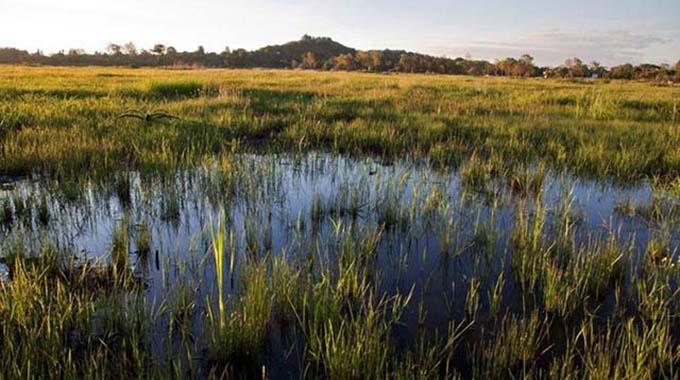Wetlands crucial in biodiversity protection

Sifelani Tsiko, Agric, Environment & Innovations Editor
It’s now close to half a century ever since the Ramsar Convention on Wetlands was signed in Ramsar, Iran, as an international treaty to strengthen the management and wise use of wetland resources.
World Wetlands Day is held on February 2 annually to celebrate the 1971 adoption of the International Convention on Wetlands in the Iranian City of Ramsar.
Every year, Zimbabwe joins other countries across the world to promote the efficient conservation and legal protection of wetlands which are coming under increasing threat due to human activities.
This year the theme is: “Wetlands and Biodiversity” to help draw attention to the global decline in biodiversity and the crucial role of wetlands as biodiversity hotspots.
In Zimbabwe, commemorations to mark the event will be held this Friday at Njovo Primary School in Masvingo where the Environmental Management Agency (EMA), development agencies, the local community and the Ministry of Environment, Climate, Tourism and Hospitality will join hands to showcase the wise utilisation of wetlands in the area.
Activities on the day will include wetland-oriented environmental education for primary school children, technical information displays and speakers addressing wetland issues concerning the role of biodiversity to local communities.
Environmentalists estimate that more than 40 percent of all species worldwide breed in wetlands.
It is important for EMA and its partners to engage students in discussions about the importance of wetlands to biodiversity and local livelihoods, as well as the impact human activities have on wetlands.
Educational activities, such as songs and dance, drama and displays can all help to raise awareness of the value of wetlands to rural livelihoods.
Wetlands are areas where water covers the soil, or is present either at or near the surface of the soil all year round or for varying periods of time during the year, including during the growing season.
They occur where the water table is near the surface, or where the land is covered by water.
Most local authorities in Zimbabwe are selling wetlands without fully considering the importance of wetlands to the country’s biodiversity system.
As a result, a number of wetlands are increasingly coming under threat from rapid urbanisation.
The parcelling out of land by city authorities on delicate habitats not fit for construction, had according to the Zimbabwe National Water Authority (ZINWA), led to a drastic fall in the water table within Harare.
The Environmental Management Act (Cap 20; 27) defines wetlands as “areas of marsh, fen, peat-land or water, whether natural or artificial, permanent or temporary, with water that is static or flowing, fresh, brackish or salt, including riparian land adjacent to the wetland.”
Urban expansion is now the major culprit, chewing the bulk of these delicate and vital biodiversity hotspots.
Apart from construction activities, wetlands around the country are being polluted heavily due to the collapse of sewer and water reticulation systems.
In most urban areas, it’s now a see-saw — struggle — oscillating between the need to build houses, versus the need to protect nature from unsustainable development.
Environmentalists in Harare have fought a bitter struggle to save the Monavale Vlei and Cleveland wetlands.
Volunteer conservationists, supported by such groups as BirdLife Zimbabwe, have over the years won legal battles to save wetlands within the greater Harare area.
We must tip our hats in honour of such selfless individuals who have spearheaded campaigns to save the vital and life-giving ecosystems.
The fight needs to be expanded to all parts of the country to save wetlands which play a vital role to life and improve rural livelihoods.
Wetlands are productive environments that support biodiversity and are critical in the survival of many species of plants, birds and animals.
Even humans who live in and around the city benefit a lot from the biodiversity around wetlands.
Encroachment into the Cleveland wetlands and many others across the country has opened up the areas to illegal sand poaching, deforestation, unsustainable farming practices and garbage dumping.
Wetlands in Zimbabwe are under threat due to agricultural expansion, rapid urbanisation, the drilling of boreholes, quarry extraction, deforestation and pollution.
Lack of proper management of the sites, in some cases, has also led to over-fishing, siltation and the endangering of the fragile wetland ecosystem.
Wetlands are habitats to a wide range of plants and wildlife. They are responsible for recharging the water table, filtering and purifying water, preventing soil erosion, siltation and flooding.
Wetlands present a platform for ecological services, regulating and providing convenient water for many communities supporting fauna and flora.
Due to their significance in the production of food, wetlands are a key factor in the eradication of famine both at micro and macro levels — being life savers in real terms.
Wetlands are also handy in purifying and replenishing groundwater.
They act as sponges in holding water during the rainy season before releasing it slowly to the surface. They are buffer zones that reduce flooding and mitigating against climatic disasters such as droughts.
Environmentalists say they also serve as natural sewage treatment works, absorbing chemicals, filtering pollutants and sediments, breaking down suspended solids and neutralising harmful bacteria.
Laws that criminalise wetland abuse include the Environmental Management Act, Regional, Town and Country Planning Act, Urban Councils Act and Traditional Leaders Act.
The country has seven protected wetland sites and a total of 1 117 wetlands covering 793 348 hectares which is about 1,5 percent of the country’s land area.
Zimbabwe now needs to take practical steps to stem the progressive encroachment on and loss of wetlands now and in the future through collaboration with various local and international organisations.
The country, which ratified the Ramsar Treaty in 2011, now has seven wetlands that have been declared as Ramsar sites.
These include the Monavale Vlei, Cleveland Dam, Mana Pools, Lake Chivero, Driefontein Grasslands, Chinhoyi Caves and the Victoria Falls National Park.
Monavale Vlei, Lake Chivero and Victoria Falls wetlands were once on the verge of complete destruction through rapid urbanisation but intense lobbying saved the fragile ecosystems.
The designation of a wetland as a Ramsar site enables the exchange of standardised information on conservation practices and technical assistance and lends international tourism value to a place.
According to the Intergovernmental Science-Policy Platform on Biodiversity and Ecosystem Services (IPBES) report released in 2019, Africa is experiencing a dramatic loss of biodiversity.
Experts estimate that by 2100, climate change alone could cause the loss of over half of African bird and mammal species, as well as trigger a 20 – 30 percent decline in lake productivity (the plant and animal life produced by a lake), and a significant loss of plant species.
The IPBES report says there has been a 15 percent increase in global per capita consumption of materials since 1980 and a 300 percent increase in food crop production since 1970, reducing the habitat of some species and causing pollution through fertilisers.
Furthermore, 85 percent of wetlands present in 1700 had been lost by 2000 and 3,5 percent of domesticated breed of birds were extinct by 2016.
Africa which is home to a rich and diverse animal, plant, and marine biodiversity could lose this vital ecosystem service which drives the continent’s economy and acts as a buffer to climate change.
Ongoing threats to African biodiversity from natural habitat loss and degradation (specially from agricultural expansion, direct over — exploitation of wildlife and fishery species and the spread of certain non-native invasive species have compounded the situation.
This loss of biodiversity affects livelihoods, water supply, food security and lessens resilience to extreme events, particularly for people living in rural areas who are often the poorest.
If no action is taken to halt the loss of biodiversity in Zimbabwe and most other African countries, the negative impact will be felt intensely in the coming decades.









Comments